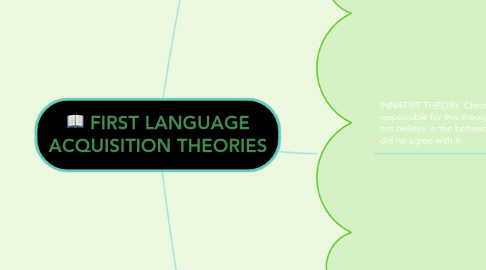FIRST LANGUAGE ACQUISITION THEORIES
作者:karen trasante


1. BEHAVIORIST THEORY: This theory hypothesizes that children learn their first spoken language through the use of stimulus, response, and reinforcement; they also use imitation and association as an essential process.
1.1. Behaviorist believe a child's mind is a, tabula rasa, translated into: blank slate.
1.1.1. This theory has proven to be the least adequate for explaining observed acts in child language development.
1.2. The behaviorist theory, does not explain how novel utterance is produced, even with those that are grammatically correct. However, they are original, meaning, they are not obtained through hearing or repeating from others.
1.3. Researchers have noted that parents reinforce their child for the meaning of the utterance, rather than for the grammar; because of this, Noam Chromsky, believed the behaviorist theory to be inadequate to explain child language development.
2. INNATIST THEORY: Chromsky was responsible for this theory, because he did not believe in the behaviorist theory, nor did he agree with it.
2.1. Chromsky did not believe language acquisition came form repetition or imitation. He believed children came into existence with a prewired for linguistics analysis; with an innate grammar template He believed children selected grammatical rules of the language they heard around them, as they constructed the grammar of their mother tongue. He better explained this by saying that children construct grammar through a process of hypothesis testing, to figure out which is the right way.
2.1.1. This theory places primary weight on the child, particularly on innate, biological mechanism.
2.2. Chromsky's contributions were applied by researchers to describe the child's interim grammars, at different ages and stages of their language development.
2.3. Through this theory, he concluded that children language acquisition could only be accounted for by an innate, biological language acquisition divide (LAD) or system. He believed that children acquire language with little help from parents/caregivers; to which psychologist, Howard Gardner, objected.
2.3.1. Howard Gardner deemed Chromsky;s theory to be too dismissive. He believed that adults do, in some ways, especially mothers, help their children acquire language. He believed adults were needed to build richer vocabulary, master rules of discourse, and distinguish between what is culturally acceptable/unacceptable: this led to the interactionist theory.
3. INTERACTIONIST THEORY: This theory believes caregivers play a critical role in adjusting language to facilitate the use of innate capacities for language acquisition. It takes into consideration the importance of both nature and nurture.
3.1. The theory studies closely the language mothers/caregivers use, when caring for the infant/child; it sharply contrasts with the innatist perspective.
3.1.1. This theory acknowledges both the child and the caregiver roll, in social environments. Social interaction is aimed an essential ingredient in language acquisition.
